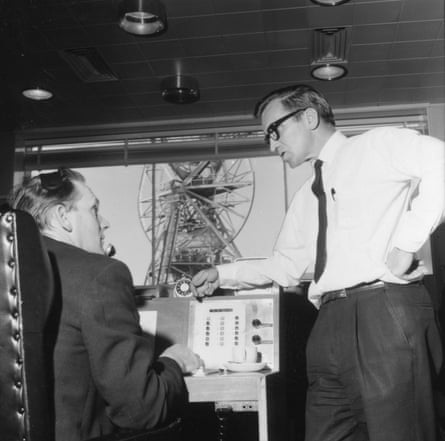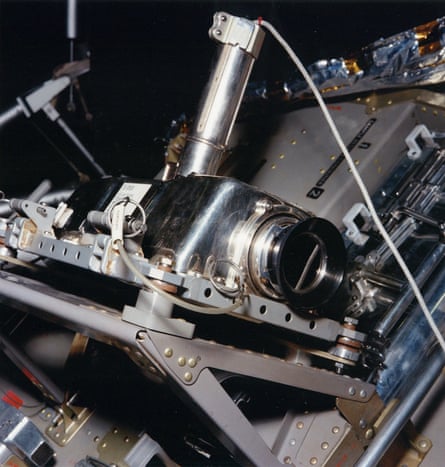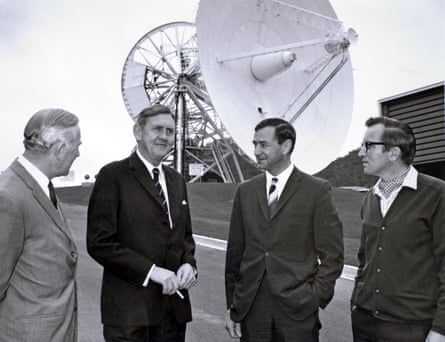Around the world more than 600 million people were glued to TV screens. Coordinated by Tom Reid, tracking stations at Australia’s Honeysuckle Creek, Tidbinbilla and Parkes, and their combined staff of almost 200, would be responsible for maintaining all communications with Apollo 11 during the crucial moon walk phase. These communications included the televising of Neil Armstrong’s first step and the monitoring of his heartbeat and respiration rate as he did so, while at the same time enabling him to give Mission Control a second-by-second description of his progress.
As Armstrong crawled backwards across the Eagle’s porch towards the top rung of the ladder, Reid realised that the TV broadcast from the moon would begin some minutes before it rose over the Parkes dish at its lowest angle of 30 degrees above the horizon. There was a chance that Parkes’s off-axis receiver might get a TV signal before that. But Tom knew that this signal would be unstable, possibly jerky, and prone to drop in and out. It would not be up to Mission Control’s broadcast standard.
Sydney Video’s Charlie Goodman would choose Honeysuckle’s more stable signal to send on to Houston, at least until Parkes’s main dish could get a signal. This meant that for Neil Armstrong’s first step, Honeysuckle’s 85-foot dish would be the only available TV back-up for Goldstone tracking station’s 210-foot dish in California, which because it still had the moon well in view, had just been earmarked by Houston as the prime station for live TV. Tom switched on his station-wide intercom and, momentarily suppressing a feeling of rapidly rising excitement, he barked “Battle Short!”
Only a couple of weeks had passed since Nasa had publicly committed to televising Armstrong’s first step live and there had been no opportunity to fully test and rehearse the key systems required to bring this moment into people’s living rooms. There would be no clapper boards, countdowns or hand signals to indicate when the lunar module’s TV camera would begin filming; and no one at Nasa had any idea what its pictures might look like. The challenges of the split-second decision making that lay just ahead were enormous.

Regardless of how these decisions might be made elsewhere, and Goldstone faced the same challenges, Reid was confident that at Honeysuckle, his TV technician Ed von Renouard would rise to the occasion.
Before taking his first step down the eight-foot ladder, Armstrong pulled on a D-ring which was attached to a lanyard. This activated the Eagle’s Mesa stowage bay, which swung out and down to reveal the small TV camera inside it. Due to earlier overheating, the TV circuit breaker had been removed.
Almost immediately, an image appeared on Ed von Renouard’s slow scan converter. For a split second what he saw confused him.
“It was an indecipherable puzzle of stark blocks of black at the bottom and grey at the top, bisected by a bright diagonal streak. I realised that the sky should be at the top, and on the moon the sky is black, so I reached out and flicked the switch and all of a sudden it all made sense, and presently Armstrong’s leg came down.”

As had been planned so as to save room in the stowage bay, the lunar module’s TV camera began automatically filming from an upside-down position. To compensate for this, Ed had remembered to engage the toggle switch on his scan converter which immediately flipped the TV picture the right way up. That done, Honeysuckle began transmitting broadcast quality pictures to Houston. Tom Reid was well pleased with the TV footage which filled the little screen on the monitor in front of him, showing Neil Armstrong slowly making his way down the Eagle’s ladder.
At Goldstone, however, confusion had set in immediately after Armstrong pulled the D-ring. The station’s prime shift had gone off duty. It was one of the technicians on the back-up shift who had been left in charge of Goldstone’s scan converter.
Stan Lebar later recalled: “I was listening to the communications traffic and heard someone say, ‘Make certain the reverse switch is in the reverse position’. A couple of minutes later a second voice made the same announcement and a bit later another voice repeated the message. After that it would be a miracle if the switch was in the correct position as I could almost visualise someone throwing the switch each time the message was sent. I suspect by then the operator was so hyper that he didn’t know what position the switch was in.”
By now thoroughly confused, the Goldstone technician increased the contrast on the scan converter’s output, dragging most of the picture into the black and making it very high-contrast. Still struggling, his next mistake was to adjust the focus, the result being that the picture was not as sharp. And a little while after that, he tried another setting, turning the picture to negative. This had the effect of compressing the shadow areas into white.

The responsibility for choosing which TV images to put to air rested on the shoulders of Mission Control’s Ed Tarkington, known by his call sign “Houston TV”. Arrayed in front of Tarkington, in a room behind the main Mission Control room, were a number of monitors showing the TV images coming in from the tracking stations that had the lunar module in view. Generally speaking the bigger the dish, the better the TV image. Tarkington could not at first understand why the TV pictures he was seeing on his monitor from Honeysuckle were so much better than the ones he was seeing from Goldstone. How was it that Tom Reid’s team, where there was not an American accent to be heard, was outperforming Nasa’s prime station in California with its much larger dish?
Putting his faith in the bigger dish, Tarkington had at first chosen Goldstone’s TV images to put to air. As he continued watching, it was impossible to make out what Armstrong was up to. Knowing that the director of flight operations, Chris Kraft, had thrown his considerable prestige behind the last-minute decision to televise Armstrong’s first step live, Tarkington instinctively understood that Kraft would be as unhappy as he was with Goldstone’s indecipherable pictures going to air. Still, he gave Goldstone one last chance. And 17 seconds after the Lunar Module’s camera had begun filming, Tarkington contacted Goldstone on Net 2:
HOUSTON TV: Goldstone video, Houston TV.
GOLDSTONE: Goldstone video, go ahead.
HOUSTON TV: Can you confirm that your reverse switch is in the proper position for the camera being upside down?
GOLDSTONE: Stand by, we will go to the reverse position ... We are in reverse.

Thirty-one seconds had now passed since the beginning of filming and Goldstone was still having trouble. Meanwhile, oblivious to all this drama at Mission Control, Armstrong had continued to make cautious but steady progress down the ladder. The Eagle’s landing struts were designed to telescope, cushioning any landing impact. But having landed gently, Armstrong found that there was a larger gap between the ladder’s bottom rung and the moon’s surface than he had planned for. He dropped off the bottom rung onto the strut’s footpad and then immediately jumped back up again to see whether he could overcome this gap. “It takes a pretty good little jump,” he said. After that, he stepped back down onto the footpad.
At Honeysuckle, staff had come from all over to stand silently behind Ed von Renouard’s scan converter, their eyes glued to his TV monitor. Secretaries, cooks, gardeners and many, many others stood stock-still and silent, like a column of terracotta warriors. But there were too many of them for the confined space. There was an announcement over the station’s intercom: “Will all personnel move away from the scan converter please.” Then Ed Tarkington was heard on Net 2:
HOUSTON TV: All stations, we have just switched video to Honeysuckle.
Having waited some more for the team at Goldstone to come good, Tarkington had finally given up on them. It was thanks to Honeysuckle that, for the first time, 600 million people could clearly make out Neil Armstrong.
This worldwide TV audience had just heard Armstrong say: “I’m at the foot of the ladder. The LM footpads are only depressed in the surface about one or two inches, although the surface appears to be very, very, fine grained ...”
It had been at this point in Armstrong’s voice transmission, one minute and 45 seconds after filming had begun, that Honeysuckle’s TV signal had first been seen by the world. For another 25 seconds, Armstrong continued to hold onto the lunar module’s strut. And with one of his boots still on the Eagle’s footpad, he tested the lunar dust with the tip of his other boot. Then he said: “As you get close to it, it’s almost like a powder. The ground mass is very fine ... I’m going to step off the LM now ...”
What followed was a short pause in Armstrong’s voice transmission during which Honeysuckle’s TV signal showed him letting go of the strut and stepping backwards to plant his left foot in the lunar dust. It was 12.56 pm at Honeysuckle when Armstrong said on Net 1: “That’s one small step for (a) man, one giant leap for mankind.”
Tom Reid and his Honeysuckle team had nailed – they had absolutely nailed – live television of this supreme moment: the culmination of more than a decade’s work by almost half a million people, when a human being had, for the first time in history, set foot on a celestial body.
Comments (…)
Sign in or create your Guardian account to join the discussion